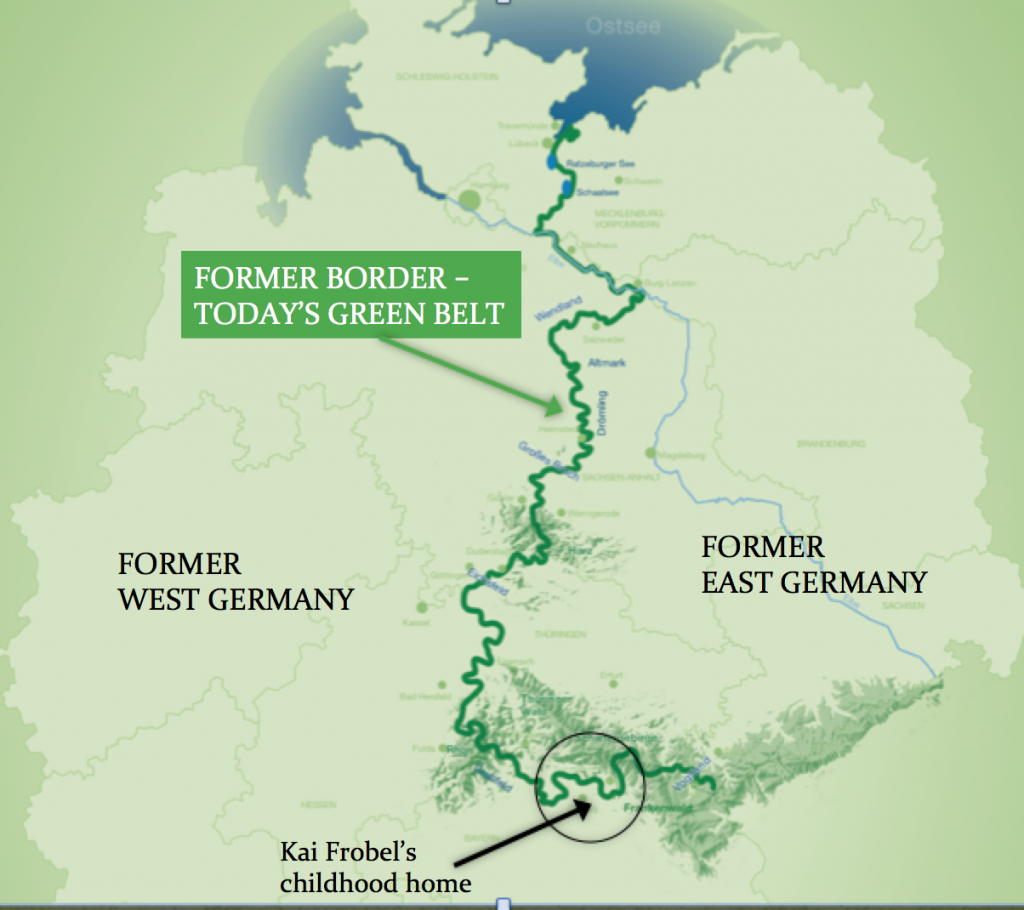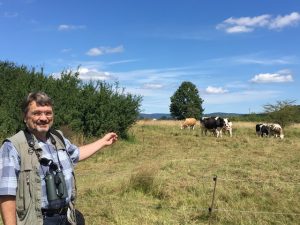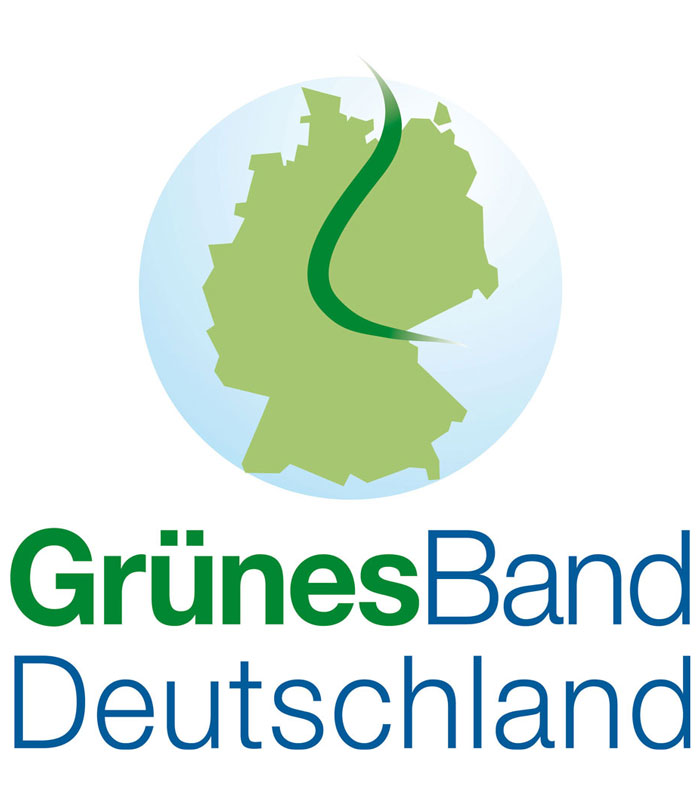
Why “the end of the world?” you may ask. For the people who lived near it, the border between East and West Germany might as well have been the end of the world. For birds – and for countless other wild creatures – the deadly border was a lifeline in an increasingly inhospitable modern agricultural landscape. The following is an excerpt from my chapter about Kai Frobel, the “father of the Green Belt,” with whom I met up for a field walk during my bicycle expedition along the former border.

The night air has done little to cool my tiny but gemütlich B&B room from the previous day’s heat, and my groggy attempts to hunt down a hungry mosquito remained unsuccessful. But as the morning sun coaxes my eyelids open, I remember the plan for the day: To explore the Green Belt with Kai Frobel.
I’ve been fascinated by the story of the Green Belt, and the way it is so closely intertwined with Kai’s own life, ever since I first heard about it. By how, as a schoolboy, he noticed that the only place he would see rare bird species was along the border with East Germany, which ran less than a kilometer from his childhood home on the West German side. How many school children are tuned in to birds enough to know when they see a rare species? And Kai not only recognized them, he also kept records of his observations, year after year. In 1977, when he was seventeen, he wrote up his findings and entered them into a science contest held by the Bavarian environment ministry.
His entry won first prize, but that was not the most important thing. The truly important thing was that his report was the first to document the unusual biodiversity in the border strip, and that was crucial when the Berlin Wall fell and the border became obsolete thirteen years later, in 1989.

By then, Kai had earned a PhD in geo-ecology and was working at the conservation organization BN. I had heard about the impressive cross-border meeting he and a colleague had pulled off: The meeting, only one month after the fall of the Berlin Wall, where they presented the resolution to preserve the border strip as a nature preserve. In those days of chaos following the completely unexpected demise of the border, in a time before email or social media, and before there were phones in most East German households, the two had managed to get 400 people together – the majority from East Germany – in response to invitations they had mailed to the 27 addresses they had. When Kai read the resolution and asked for a vote, every single hand went up.

I’ve written down what feels like a thousand questions I want to ask him, but now, sitting in the morning sun and looking at my map of the nearby section of the Green Belt, all I can think of is the prospect of joining him on a field walk. As much as I love hiking and simply spending time in the woods, over time I have come to appreciate the value of field walks and how by looking closely and trying to figure out the pieces, patterns, and processes of a landscape, one can develop a grounding in the land. This deeper sense of connectedness to a place always feels like a reasonable tradeoff for the sometimes gratingly slow pace of spending time in nature this way. Hiking with caterpillars, Vermont naturalist Bryan Pfeiffer likes to call it.
My watch shows close to ten now, the time Kai suggested we meet at the Wasserschloss hotel. I ask the breakfast server to save some coffee and position myself near the front door. The next time it opens, he steps in, looking so much like the pictures I’ve seen of him in the BUND publications that it almost feels as if I have met him before. A sympathisch face with friendly brown eyes and a beard. Just like in those pictures, too, he looks ready for a field walk, in sturdy boots, jeans, and a field vest over a casual shirt – and with a pair of binoculars strung around his neck.

I have an inkling from what I’ve read that getting the border strip designated as the Green Belt was a piece of cake compared to the ongoing challenge of overseeing a 1,400 kilometer long nature preserve: the behind-the-scenes work of raising money, talking to landowners, negotiating land purchases, navigating legal issues and protection categories; combined with the on-the-ground work of keeping open habitats from overgrowing, installing interpretive signs, and conducting biological inventories. Except in this case, there are the extra layers of coordinating with nine of Germany’s sixteen federal states, of navigating a project that straddles conservation and historic preservation, and of protecting something that in the eyes of some should not be preserved at all because it is a reminder of the brutal separation. Some even feared a repeat of the expropriations that had happened in GDR times. How did this all work, and how had he gotten over that first obstacle, proposing to preserve the death strip?
“Right,” he reflects, “just imagine the atmosphere at the time, in December 1989. The border had been open for just a few days in some places, a few weeks in others. It was an amazing time, a euphoric time, when everyone, myself included, was just elated that this border was finally gone. And then we conservationists come and say, folks, let’s preserve the border as a component of the landscape. That could really have backfired! Politicians, too, could have said, you guys are out of your minds.
“But we knew that there would soon be enormous pressure on this strip of land. And fortunately, the resolution was well received, and the media did a good job explaining the significance. My colleague Hubert Weiger and I had written it up by hand during a break in that first meeting. And we had to decide what to call it. Of course we couldn’t call it by any of the previous names – the zonal border, the death strip, the demarcation line, the antifascist protection wall. So I thought, why not call it Grünes Band – “Band” (ribbon or belt) to indicate its linear shape and “grün” (green) to signal nature and everything alive. And that name has really worked and stood up to time. It’s quite a popular term, and it’s been anchored in the the Federal Law on the Conservation of Nature for years now.”
Stay tuned for Part 2…


This blog on the Green Belt is so heartening – such a beautiful story about caring for the environment, and one person his passion that led to the preservation of this amazing oasis for wildlife. Wonder if some other places to place this as an article might be National Audubon, Nature conservancy…. among others.
Great job, Kerstin!
Thank you Julie, so glad you are reading along and that this story resonates with you!
Claudia Stoeffler
August 1, 2020
Kerstin, I love the tone of your writing as you describe your meeting with Kai Frobel to explore the Green Belt together. You mention Kai’s report, which was the first to document the unusual biodiversity in the border strip between former East and West Germany. All of these pieces you then simultaneously weave together in a beautiful narrative that allows the reader to follow you on your journey.
Thank you for this great feedback Claudia!
This is really interesting; thank you for sharing. I can’t wait to read more about Kai Frobel, the Grünes Band, and your journey.
Thank you so much Megan; more about Kai Frobel and the Grünes Band is on its way!